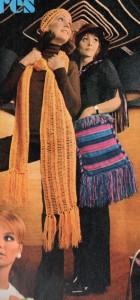 Although the days when I was a svelte 110 pounds are long gone, I still like to read the fashion magazines while I stand in line at the grocery checkout, and imagine what new styles I would wear if I still had the body to carry them off.
Although the days when I was a svelte 110 pounds are long gone, I still like to read the fashion magazines while I stand in line at the grocery checkout, and imagine what new styles I would wear if I still had the body to carry them off.
So I had to laugh when I read about the latest in fall fashions.
The fashionistas, in an apparent belated nod to the 9/11 disasters, are selling the idea of a “sartorial safety net,” according to Globe fashion maven Tina Cassidy. The new trend is to dress as if your dotcom fortune tanked and terrorists destroyed your apartment, and you had to make do with stuff from the attic and the nearest Salvation Army bin. Clothes as camoflage. The brittle, all-in-black-all-the-time “Sex in the City” look is out. Logo-splashed accessories are out. “I have more money than God” separates made from the collected silk of endangered spiders handwoven by indigenous artisans dwelling in photogenic mountain ranges are out. Intimidation is out. Comfort (physical and spiritual) is in.
And how is this achieved? With clothes that look like relics from the cartons stashed in my sister’s cellar. I mean, when was the last time anyone saw a tight, horizontally striped longsleeved knit top, worn over an open-necked polyester satin shirt, outside of a Mod Squad rerun? Or a crocheted vest over bellbottomed lowrider jeans? Or an oversized navy peacoat, a seven-foot handknitted striped scarf and a knit cap pulled down to eyebrow level? Try back in 1970. That’s how I dressed in eleventh grade, and I have the yearbook pictures to prove it. Not that I’d ever show them to you.
Orange and rust are big colors this year. Bell-bottomed jeans weighed down with rawhide laces, fringed belts and thick layers of patches. Peasant blouses with bell sleeves and embroidery. Hair straight, center-parted, and preferably blonde. (You gals all think you look like Britney Spears. I look at you and think, “Marcia Brady.”) All that’s missing is the enormous hoop or miniature-chandelier earrings and embroidered chambray workshirts. Wait—didn’t I just see those on sale in Filenes?
But I’m waiting for the really good stuff to come back. Three-foot tall, clunky-heeled Frye boots. Wide, pleated, plaid pants with deep cuffs. Falls. (For the uninitiated, these are half-wigs that are pinned to the top of the head to provide length to short hair. Nowadays they’re called ‘hair extensions.’) High-waisted “Juliet” mini-minidresses that double as peasant tops. Silver lipstick and heavy black eyeliner. Slippery-looking Qiana blouses. Hot pants.
For men, it gets even better—ties a foot wide in thick, impossible-to-knot synthetics. Long, droopy shirt collar points. Jacket lapels that extend beyond the shoulders. Sideburns. Tight ribbed longsleeved T’s with an industrial zipper placket closing. High-contrast topstitching everywhere. Leonard Whiting/Davy Jones haircuts. (Do a Google search if you don’t know who they are.) And the ultimate in 70’s fashion for men—polyester leisure suits. We’re not talking disco here—it’s a decade prior to that—a strange, bastardized blend of American Monterey-Woodstock commune fashion and British Mod, filtered through a high-school sensibility.
When my friends and I emerged from the 70’s, we hoped we would never see such ugly clothes again. Surprise! Time was when dressing in “vintage fashions” (sounds like they are sold in bottles) meant stuff you could only find in specialty secondhand stores or auctions; fragile, lacy museum pieces from the 1930s and 40s—things that were once worn over whalebone corsets.
Now, to dress in “vintage,” all I have to do is dig out that First Day of School outfit from 1970—the one with the macrame shoulder bag and peasant blouse. The definition of “antique” has telescoped to a mere thirty years… which happens to be the age differential between me and most other students on campus. Everyone is walking around looking like Ali McGraw in “Love Story,” and I have a crazy urge to sing, “Let’s do the time warp again!”
I can hardly wait until they bring back disco fashions. Oh, joy.
No comments yet